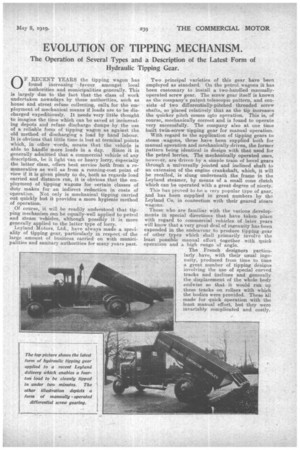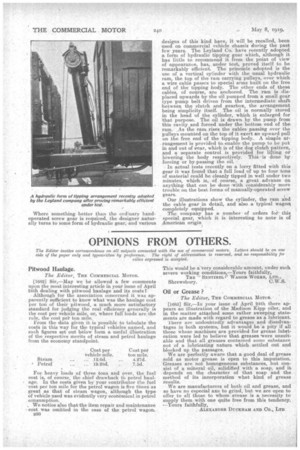EVOLUTION OF TIPPING MECHANISM.
Page 19

Page 20

If you've noticed an error in this article please click here to report it so we can fix it.
The Operation of Several Types and a Description of the Latest Form of Hydraulic Tipping Gear.
OF RECENT YEARS the tipping wagon has found increasing favour amongst local authorities and municipalities generally. This is largely due to the fact that the class of work undertaken nowadays by these authorities, such as house and street refuse collecting, calla for the employment of mechanical means if loads are to be discharged expeditiously. It needs very little thought to imagine the time which can be saved at incinerating depots and refuse discharge dumps by the use of a reliable form of tipping wagon as against the old method of discharging a load by hand labour. It is obvious that little time is lost at terminal points which, in other words, means that the vehicle is able to handle more loads in a day. Since it is, generally admitted that a commercial vehicle of any description, be it light van or heavy lorry, especially the latter class, offers best service both from a remunerative as well as from a running-cost point of view if it is given plenty to do, both as regards load carried and distance run, it is obvious that the employment of tipping wagons for certain classes of duty makes for an indirect reduction in costs of operation. Not only is mechanical tipping carried out quickly but it provides a more hygienic method of operation.
. Of course, it will be readily understood that tipping mechanism can be equally-well applied to petrol and steam vehicles, although possibly it is more generally applied to the latter type of lorry. Leyland Motors, Ltd., have always made a speciality of tipping gear, particularly in respect of the large amount of business carried on with municipalities and sanitary authorities for many years past. Two principal varieties of this gear have been employed as standard. On the petrol wagons it has been customary to install a two-handled manuallyoperated screw gear. The screw gear itself is known as the company's patent telescopic pattern, and consists -of two differentially-pitched threaded screw shafts, so placed relatively that as the tip increases the quicker pitch comes into operation. This is, of course, mechanically correct and is found to operate very successfully. The company also at one time built twin-screw tipping gear for manual operation.
With regard to the application of tipping gears to steam .wagons, these have been supplied both for manual operation and mechanically-driven the former Pattern being identical in design with that used for the petrol lorries. The mechanically operated ones, however, are driven by a simple train of bevel gears through a universally jointed and inclined shaft to an extension of the engine crankshaft, which, it will be recalled, is slung underneath the frame in the Leyland steamer, by means of a small cone Clutch which can be operated with a great degree of nicety.
This has proved to be a very popular type of gear, and has been supplied in great numbers by the Leyland Co. in connection with their geared steam wagons.
Those who are familiar with the various developments in special directions that have taken place with regard to commercial vehicles of later years will know that a very great deal of ingenuity has been expended in the endeavour to produce tipping gear of other types which shall primarily involve the least possible manual effort together with quick operation and a high range of angle.
The French designers particularly have, with their usual ingenuity, produced from time to time a great number of tipping designs involving the use of special curved tracks and inclines and generally the displacement of the whole body endwise so that it would run up these tracks on rollers with which the bodies were provided. These all made for quick operation with the least manual effort, but they were invariably complicated and costly.
Where something better than the ordinary handoperated screw gear is required, the designer naturally turns to some form of hydraulic gear, and various designs of this kind have, it will be recalled, been used on commercial vehicle chassis during the past few years. The Leyland Co. have recently adopted a form of hydraulic tipping gear which, although it has little to recommend it from the point of view of appearance, has, under test, proved itself to be remarkably efficient. The principle adopted is the use of a vertical cylinder with the usual hydraulic ram, the top of the ram carrying pulleys, over which a wire cable passes to special arms built on the free end of the tipping body. The other ends of these cables, of course, are anchored. The ram is displaced upwards by the Oil pumped from a small gear type pump belt driven from the intermediate shaft between the clutch and gearbox, the arrangement being simplicity itself. The oil is normally stored in the head of the cylinder, which is enlarged for that purpose. The oil is drawn by the pump from this cavity and forced under the bottom end of the ram. As the ram rises the cables passing over the pulleys mounted on the top of it exert an upward pull on the free end of the tipping body.. A simple arrangement is provided to. enable the pump to be put in and out of gear, which is of the dog clutch pattern, and a separate control is provided for lifting or lowering the body respectively. This--is done bg forcing or by-passing the oil.
In actual tests recently on a lorry fitted with this gear it was found that a full load of up to four tons of material could be cleanly tipped in well under two minutes, which is, of course, a great advance on anything that can be done with considerably more trouble on the best forms of manually-operated screw gears.
Our illustrations show the cylinder, the ram and the cable gear in detail, and also a typical wagon completely equipped.
The company has a number of orders foi" this special gear, which it is interesting to note is of American origin






















